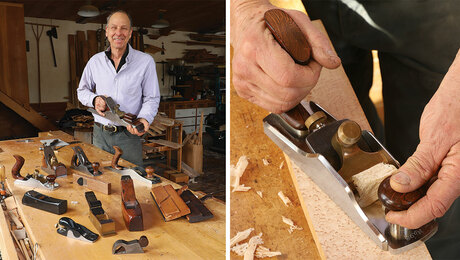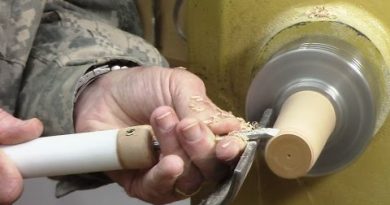Woodworking Beginners: Secret Tips To Start Right
Woodworking: Where To Start – Tips From Experienced Woodworkers
Woodworking encompasses a broad area of skills, specialties, and applications. Some beginners take on too much too soon or blow their savings on expensive woodworking tools and machines that they don’t know how to use and might not ever need. And even some basic techniques can be confusing or easy to do incorrectly. Experienced woodworkers have some simple, but insightful tips to help you get off to a good start.
Do Your Research
The initiative, courage, and a sense of adventure, are all good things, and many fine woodworkers learned their skills by just jumping in and trying to build something. Chances are whatever they chose for their first project, it came out better than they thought, but not nice enough to use or display. Even those brave souls that start from scratch with no preparation often end up seeking out some books, magazines, or experienced woodworkers to figure out how to do it right.
The woodworkers we talked to stressed that a person can save themselves some time and frustration by learning about the different aspects of woodworking before starting a first project. Many suggested finding some good books or magazines, either at the library for free or at the bookstore. Start with the basics and learn about different forms of woodworking, types of trees and woods and how they are used, various tools, etc. – just the kind of information presented here in this article.
“I have an entire corner of my garage filled with books and magazines,” shared Paul Johnson, who has been woodworking since he was a young boy. “I subscribe to a couple and keep those that have projects or techniques that I would like to try. I also buy a couple of new books every year.
When I first started woodworking, I bought them left and right; whenever I came across one that was recommended or had the information I wanted to learn. They help give me ideas for projects,” he added. “I especially like those that come with patterns.”
After learning about the basics, you should have an idea of what type of woodworking interests you, and you can move on to books or even classes that teach hands-on skills in that particular area.
Take Some Classes
Taking classes was recommended by several of our experts. Whether it’s a beginning class through the local college or something taught by an experienced woodworker, it will typically give you a good overview of different tools and woodworking safety. Some building centers and lumberyards also offer classes on basics or teach you how to make a specific project.
If you aren’t big on classes, but you know a person who is skilled in woodworking, ask if they would let you assist them with a project, or perhaps just sit and observe. Most woodworkers are pleased to talk about their art and share it with others. Chances are they will be happy to oblige.
Keep It Simple
The answer, “Keep it simple,” came up over and over, when asked for advice for new woodworkers. Start with simple projects, preferably those that use only hand tools. This way, you will learn how to do the important things like measure, cut, shape, and join. Getting good at those basic skills is extremely important.
If you are brand new to woodworking and haven’t used tools much before, you might want to consider starting with a precut kit. Most kits consist of wood that is already cut in the appropriate shapes and sizes. It is up to you to follow the directions and put the pieces together. These kits typically require nailing, screwing, gluing, sanding, and finishing. You can make birdhouses and feeders, benches, plant holders, and many other fun items to get you started.
Even as you advance to more complex projects, don’t worry about planning and sizing your lumber until you feel comfortable and confident. You can buy lumber already prepped and cut in many different widths. And table legs, chair spindles, and other turned pieces are also readily available pre-made. Ease into some of those more difficult projects over time, adding greater levels of difficulty to each project.
Tool Tips
The suggestions to keep it simply applied to woodworking tools as well. Most people interviewed recommended buying tools as you need them and adding to your selection as required for new projects. If a project is purchased as a kit, or with printed instructions, the list of tools needed is included. Depending on what type of projects you choose to start with, you will typically need hammers, tape measure, clamps, a square, saws, hand drills, and a set of chisels. These will probably cost you around $200-300 dollars.
Some woodworkers said that investing in a good table saw early on was important, but only if you will be doing projects with many cuts, especially those with different types of angles. For most beginner projects, a handsaw, or perhaps a circular saw will suffice.
It is strongly suggested that you begin by buying good tools, but not top grade until you decide for certain that you want to stick with woodworking. If it becomes clear that this will be an ongoing interest, then consider buying the best quality tools you can afford. The best quality doesn’t always mean the most expensive, and you will have to do your research.
Kevin Warner, who has been teaching high school shops for over twenty years, had this to say about woodworking tools. “At school, I have a limited budget for tools, but I would rather buy a few high-quality tools and have the kids share them than spend my money on cheap equipment. There’s nothing that will turn a young beginner away from woodworking quicker than a crappy tool that doesn’t do what it should.”
The same is true for home woodworking. Our experts recommended spending as much as you could afford on basic tools like hammers, saws, screwdrivers, drills, and bits. “These are tools you will need around the house even if you don’t pursue woodworking,” Sarah Greeley pointed out. “If you spend the money upfront, and care for them correctly, these tools will last you a lifetime because you bought quality, to begin with.”
If you have a tight budget, consider purchasing tools at an estate sale, auction, or garage sale. Some may have worn handles or look like they are rusty or dirty, but if they are quality tools and generally sound, you can clean and repair them for less than it would cost to purchase new ones.
In general, you get what you pay for with woodworking tools, but sometimes you pay for the name, or for features that you may not use in your particular type of woodworking. So again, you will need to refer to books, magazines, Web sites, and other woodworkers to learn more about different types and brands of tools. And so you see, the tips have brought you full circle, back to the research and learning, which is what so many woodworkers stressed the most.
There is much to learn and, as has been said, it is an ongoing process. But thanks to the wealth of information out there about different aspects of woodworking, and the many Web sites and Internet resources, it is easy to research your questions. You just have to take the time.
Source by Ferhat Gul




